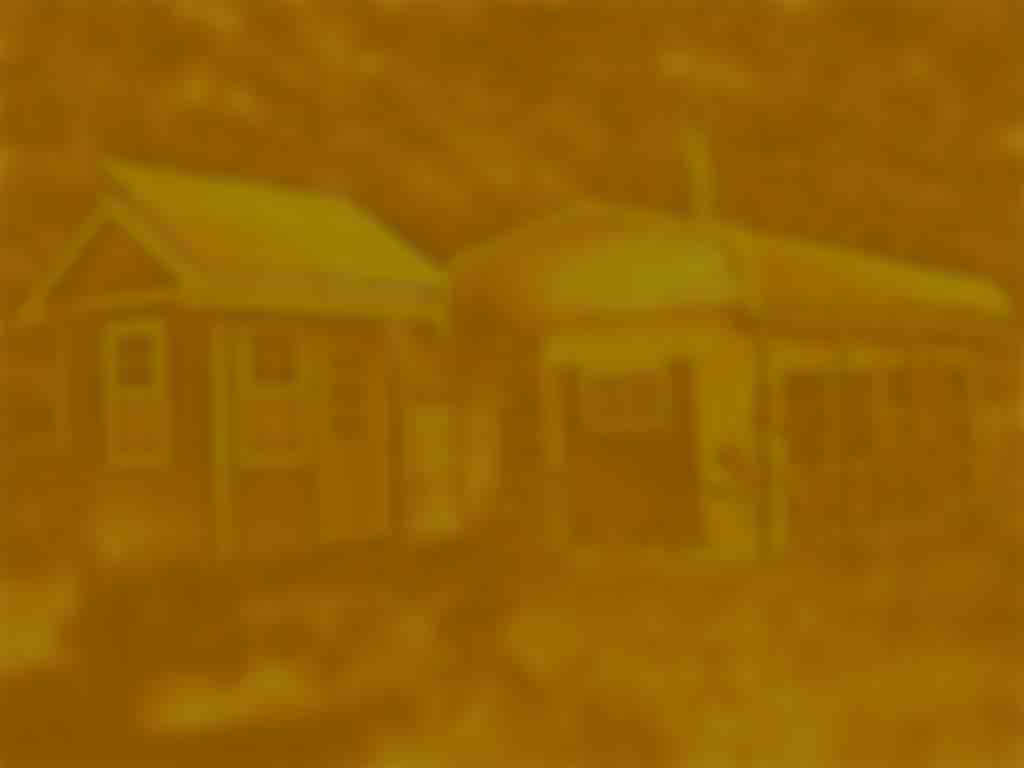|
|
|
The Missing Corner:
The day before my departure I climbed the hill. I was hoping to find the mythical 4th corner. I've known about the bottom SW corner since day 1, 1967. The 2nd and 3rd I
found last year, 2006. I have heard about the 4th corner from a rock climbing occasional neighbor but I did not find it when I went looking this time. I was sure I would find it; I even carried a long PVC pipe with me to flag it like I had the others but it was not there. I had found the other 2 because I could get a line of sight on the street grid far below and zero in on where they would have to meet. That didn't work this time because various ridges blocked the view of the distant grid and my best logically considered guesses didn't work.

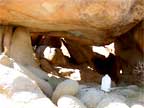
This was my only time up there this trip and I'm glad that circumstances and the weather permitted it. Occasionally a year goes by without my having climbed the hill and that always leaves me with an almost subliminal sense of loss that stays with me. The far off views are indeed breathtaking and the quiet close up observations are fascinating leaving me with a deep sense of gratitude that I had stumbled into this irresponsible purchase when I was still a kid, and that I somehow managed to just barely hold onto it when financial times were desperate.

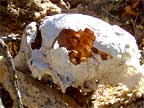 Next time I go up there I will first print out a satellite photo to get exactly where that corner has to be. Then with photo in hand I will locate the boulders that are near that corner. Unfortunately the resolution on that satellite shot is not that good; close-ups are blurred. I check once in awhile to see if Google-Earth has gotten a better shot but so far no luck. I guess the outlying desert areas are a low priority; they probably like to focus on concentrations of people. I can get a pretty good overhead of the vehicles that were passing through the town of Joshua Tree when the satellite image was captured, but boulders of the same size on my land are hard to make out due to a lack of contrast; the boulders blend with the surrounding soil.
Next time I go up there I will first print out a satellite photo to get exactly where that corner has to be. Then with photo in hand I will locate the boulders that are near that corner. Unfortunately the resolution on that satellite shot is not that good; close-ups are blurred. I check once in awhile to see if Google-Earth has gotten a better shot but so far no luck. I guess the outlying desert areas are a low priority; they probably like to focus on concentrations of people. I can get a pretty good overhead of the vehicles that were passing through the town of Joshua Tree when the satellite image was captured, but boulders of the same size on my land are hard to make out due to a lack of contrast; the boulders blend with the surrounding soil.
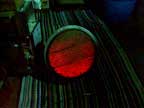 I want to add some comments about the propane catalytic heaters that we use - great little inventions. Since there is no combustion and therefore no silent fumes they are safe to use indoors, though they can probably suffocate a person if they use up all the oxygen.
I want to add some comments about the propane catalytic heaters that we use - great little inventions. Since there is no combustion and therefore no silent fumes they are safe to use indoors, though they can probably suffocate a person if they use up all the oxygen.
We began with the 3000 btu Coleman BlackCat heater 6 years ago, as mentioned above. After awhile it can get a small room fairly comfortable - though I will immediately retract that in regards to some winter evenings.
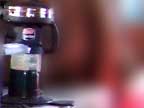 The year after that we added a small 1000 btu Coleman SportCat heater which might heat up a small tent but not our place. It kept the chill off at night. However, these 2 heaters did usually meet our needs through the next 6 years. Occasionally they did not quite get it but when the sun came over the hill at around 8:15 or so in the morning the place warmed right up. In 2006 the small one gave out; it just wouldn't light anymore. We replaced it with a new 1000 btu SportCat.
The year after that we added a small 1000 btu Coleman SportCat heater which might heat up a small tent but not our place. It kept the chill off at night. However, these 2 heaters did usually meet our needs through the next 6 years. Occasionally they did not quite get it but when the sun came over the hill at around 8:15 or so in the morning the place warmed right up. In 2006 the small one gave out; it just wouldn't light anymore. We replaced it with a new 1000 btu SportCat.
In 2007 I bought another 3000 btu BlackCat because the original was also becoming difficult to light but then I realized that I could use the old one temporarily in the van; I didn't have to sit out there freezing to death every morning while I drank my coffee, got things charging and downloaded email.
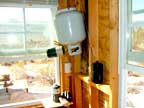
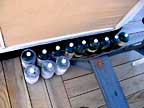
 Each heater is fueled by a small “1 pound” (actually 16.4 fl oz or 1.2 gallon) propane cylinder that screws into the bottom of the device. Our propane Coleman stove and a Coleman lantern also used them, though we decommissioned the lantern and moved the stove outside after
our CO scare of 2004.
Each heater is fueled by a small “1 pound” (actually 16.4 fl oz or 1.2 gallon) propane cylinder that screws into the bottom of the device. Our propane Coleman stove and a Coleman lantern also used them, though we decommissioned the lantern and moved the stove outside after
our CO scare of 2004.
In the beginning I had accumulated maybe 5 dozen empties before I decided to find a way to refill them. This in fact is dangerous and illegal but I readily found what I needed, the instructions online and the parts in town. I purchased two “20 pound”, aka: “5 gallon”, (actually about 19.44 fl lb or 4.6 gallon) tanks and proceeded to
refill the cylinders as needed, 10 or 11 per 20 lb tank, throughout the next 6 years. This would occur roughly every 2 to 4 winter weeks depending on how cold it got, taking the empty 20 lb tank into town for a refill ASAP.

 In January of 2008 I decided to rethink this. Between Amazon.com, Barr Hardware, Home Depot and Wal-Mart I bought 3 more 20 lb tanks, 5 Mr Heater 9,000 BTU 12 foot hoses and 5 filters to absorb microscopic oil residue from the hoses and the tanks. Each 3000 btu heater and the camping stove got its own 20 lb tank and 12' filtered hose. It would be nearly impossible to safely do likewise for the small 1000 btu heater because it requires the small cylinder to remain upright, but I'm thinking about it. These purchases reduced having to refill the small cylinders down to maybe once a year or less. What a relief!
In January of 2008 I decided to rethink this. Between Amazon.com, Barr Hardware, Home Depot and Wal-Mart I bought 3 more 20 lb tanks, 5 Mr Heater 9,000 BTU 12 foot hoses and 5 filters to absorb microscopic oil residue from the hoses and the tanks. Each 3000 btu heater and the camping stove got its own 20 lb tank and 12' filtered hose. It would be nearly impossible to safely do likewise for the small 1000 btu heater because it requires the small cylinder to remain upright, but I'm thinking about it. These purchases reduced having to refill the small cylinders down to maybe once a year or less. What a relief!
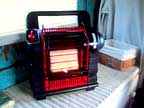 Of course in the process I discovered the
Mr Heater. I purchased a “Portable Buddy 9,000 BTU Propane Radiant Heater #MH9B” on Amazon.com for $70 plus shipping. This single purchase improved our comfort and safety levels significantly. It includes an igniter like on some gas grills. The On/Off switch allows you to select either 4000 or 9000 btus. It would be nice if it also included a 1000 btu setting but they don't seem to carry that. Except for when you first start it up, there is no flame; just a red hot high tech porous ceramic tile behind the grill. If it tips over, it shuts off. Though the heater can hold two cylinders I of course connected a filtered hose instead.
Of course in the process I discovered the
Mr Heater. I purchased a “Portable Buddy 9,000 BTU Propane Radiant Heater #MH9B” on Amazon.com for $70 plus shipping. This single purchase improved our comfort and safety levels significantly. It includes an igniter like on some gas grills. The On/Off switch allows you to select either 4000 or 9000 btus. It would be nice if it also included a 1000 btu setting but they don't seem to carry that. Except for when you first start it up, there is no flame; just a red hot high tech porous ceramic tile behind the grill. If it tips over, it shuts off. Though the heater can hold two cylinders I of course connected a filtered hose instead.
It has an oxygen sensor. When we first began to use the heater it would inexplicably shut itself off not long after we turned it on. At first I thought the tank or hose might be defective so I carried everything outside and exchanged them for another set. It still shut off. Then it dawned on us – we opened the window behind it. It has worked perfectly ever since. The 9000 btu setting heats the place quickly, then we reduce it to 4000.
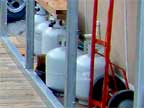
They say “Never bring a 20 pound cylinder indoors” but I think that is for people that don't think too clearly and I think it pertains to the older tanks that were outlawed a few years ago. The 20 lb propane tanks that we have are so well endowed with safety features that very little can go wrong. Judging by my experience, they are considerably safer indoors then the small 16.4 oz cylinders. The 12' hose allows us to keep the tank well away from the heater and we close the tank's valve when not in use. The hose retains some gas so we allow that to burn off after closing the valve, then shut off the heater. I store the empties and the spare full tanks outdoors in the shade.
 In 2005 I had purchased an Atwood Everest Star 16,000 BTU furnace online but never got around to hooking it up.
In 2005 I had purchased an Atwood Everest Star 16,000 BTU furnace online but never got around to hooking it up.
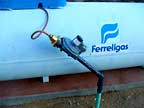 By the time it arrived I was into building the utility house which took up the rest of that stay south of Joshua Tree. Other projects superseded this one in the years to follow.
By the time it arrived I was into building the utility house which took up the rest of that stay south of Joshua Tree. Other projects superseded this one in the years to follow.
However, there were other factors that contributed to my procrastination. I had thought that I would have to get one of those large commercial propane tanks brought in which would mean laying a concrete pad to put it on and running a gas line to the furnace and to the gas stove. That would require inviting a building inspector to visit, intentionally or not, and getting a permit, etc.. Also I had no idea where I could hide the big tank; I really did not want it overwhelming my landscape. In the past I have built rock walls to hide (and to shadow) possible eyesores but the propane guy said I cannot hide it; it must be in plain view.
|
The furnace also required electricity to trigger its thermostat. I had thought I might wire it to a 12 volt battery which I could recharge from the van or generator as needed. Then a better option occurred in 2008 which will be described below under “Electricity”, an option that also made me realize that we don't even need our apartment sized gas stove, which of course was never hooked up. In fact I ended up donating it to a local thrift shop. For that matter, for the same reason, the camping stove has almost become superfluous.
With our new heating arrangement we don't even need the Atwood furnace, nor the large commercial tank. I no longer have to worry about burying a black steel pipe 18” underground through bedrock, and running copper gas lines, and etc., according to code. Nice!
I will still need to hook up the Atwood furnace temporarily to confirm that it works, and then I will sell it on eBay.
|
Copyright © 2008, Van Blakeman |
